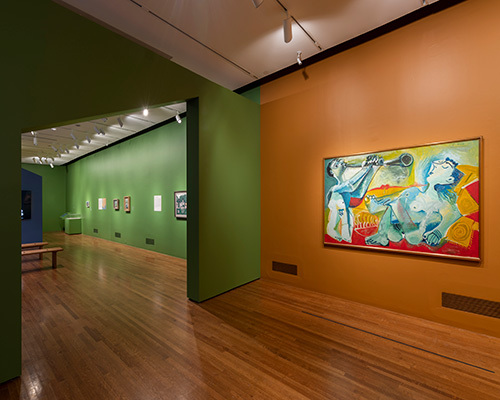Figure & Landscape
Hello, I am Cosmo Philpott, the museum’s project manager for design and marketing. I will be reading an introduction to the “Figure in Landscape” section of Picasso Landscapes: Out of Bounds.
Like countless male painters before him—from Titian and Giorgione to Renoir and Cézanne—Picasso painted many variations on the trope of the female nude in nature. Characteristically, however, he sought to transcend mere emulation and forge a new future for landscape rooted in abstraction. Accordingly, his compositions reflect numerous dualities typical of the artist; they reference work in the studio and in nature, painter and subject, landscape and model, representation and abstraction, tradition and innovation.
Despite their active engagement with the history and future of landscape, Picasso’s many representations of nude women posing outdoors or in the interior landscape of the studio merit the scrutiny of our twenty-first-century gaze. The paintings in this section partake of the inherent misogyny of this art historical motif and the false equivalency it creates between femininity and fecundity. Such concerns cannot be easily dismissed, especially in the oeuvre of an artist whose treatment of his female models and partners in life has justly been the focus of recent critical analysis.

Pablo Picasso (Spanish, active in France, 1881–1973), The Aubade, Mougins, 19–20 January 1965, oil on canvas, Association of Friends of the Petit Palais, Geneva, 10444 © 2023 Estate of Pablo Picasso / Artists Rights Society, (ARS), New York, Courtesy American Federation of Arts
Verbal Description
Hello, I am Cosmo Philpott, the museum’s project manager for design and marketing. I will be reading a description of the painting The Aubade in Picasso Landscapes: Out of Bounds.
Pablo Picasso, a Spanish artist who lived from 1881 to 1973, painted The Aubade in oil on canvas on January 19th and 20th, 1965, in Mougins, France. It is in the collection of the Association of Friends of the Petit Palais, Geneva, where its reference number is 10444.
The Aubade is a horizontally oriented painting measuring about 53 and a half by 79 and a third inches or 136 by 201 centimeters, framed. In this large, colorful picture, the artist includes two abstract nude figures, represented in shades of white, light and dark blue, and green, in an outside space. The standing male figure on the left holds a clarinet to his mouth to play. His eyes open wide, and his cheeks appear puffed out. The instrument extends along the top of the picture. A woman, reclining on orange pillows, takes up the center and right side of the painting. Her head falls back, and her eyes are closed. The artist paints the space around the figures in warm colors of red, orange, and yellow – perhaps indicating an exterior room decorated with textiles in those colors. In the background, the sky is blue, yellow, and green.
Label Text
Hello, I am Cosmo Philpott, the museum’s project manager for design and marketing. I will be reading the label for the painting The Aubade in Picasso Landscapes: Out of Bounds.
Pablo Picasso, a Spanish artist who lived from 1881 to 1973, painted The Aubade in oil on canvas on January 19th and 20th, 1965, in Mougins. It is in the collection of the Association of Friends of the Petit Palais, Geneva, where its reference number is 10444.
An aubade is an amorous morning song or poem, the counterpoint of the better-known nocturne. Picasso painted another version of this composition two decades earlier in a more starkly Cubist style, setting the scene in a dark bedroom with the musician seated and holding a lute. Here, in warm light and bright colors the serenade is set outside, its participants figured on a grand scale. Picasso revisited the subject yet again in the summer of 1967, resulting in a painting on the same grand scale, with the figures more entwined and in the cool blues and greys of a coastal setting.
The pastoral genre, which idealizes country life, has deep roots in Western art and literature. Picasso subsumes the spirit of Titian’s famous landscape with musicians and nudes—The Pastoral Concert—in the Louvre into his own pictorial language, which emphasizes the subject’s inherent eroticism.
